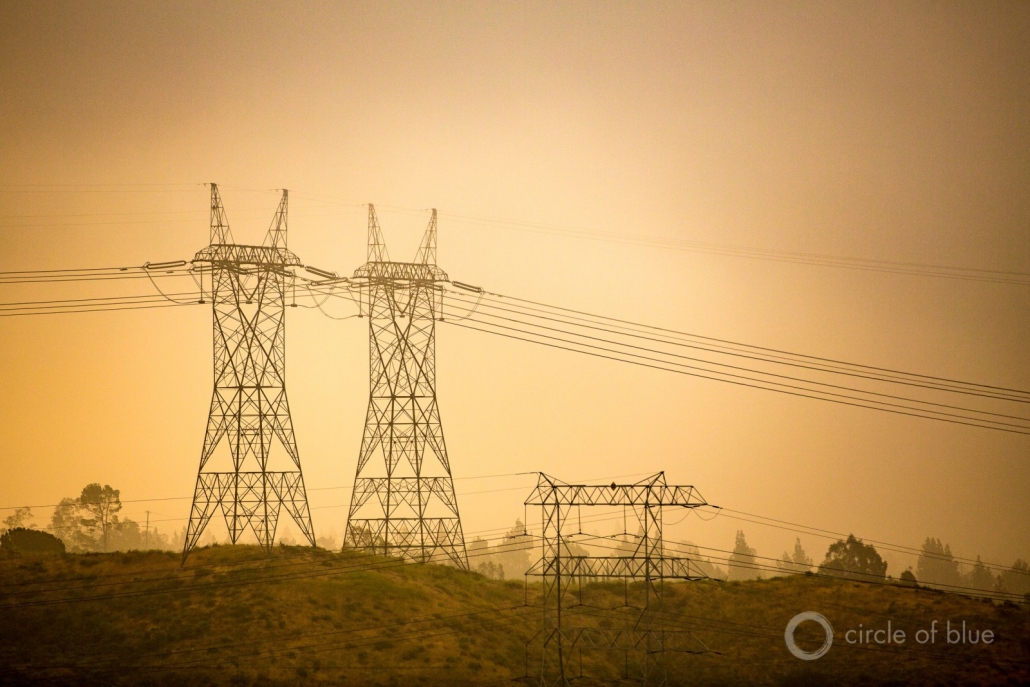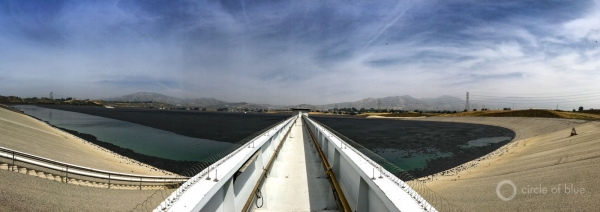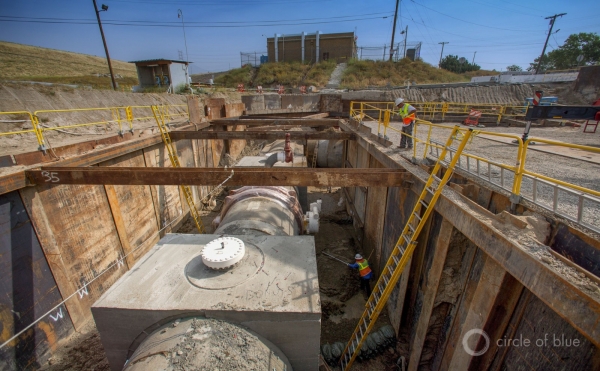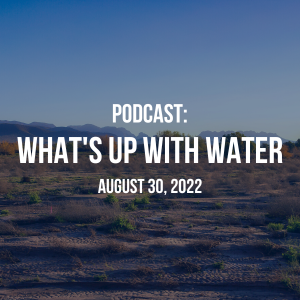Environmental review is under scrutiny on Capitol Hill. Here’s what a NEPA expert thinks policymakers should keep in mind.

From pipelines and dams to power plants and critical mineral mining, there are few industries or environments that NEPA doesn’t touch. Photo © J. Carl Ganter/Circle of Blue
On August 16, President Joe Biden signed into law a tax reform and spending bill that is also the country’s largest climate change investment. A surprise and historic compromise between Sen. Joe Manchin of West Virginia and Senate Majority Leader Chuck Schumer, the Inflation Reduction Act is projected to cut domestic greenhouse gas emissions by at least 40 percent by 2030 compared to 2005 levels, mostly through hundreds of billions of dollars in renewable energy tax credits.
In exchange for his vote, Manchin, who has a stake in a family coal business, secured a legislative concession: the promise of a side deal to speed the permitting process for big energy projects.
What little is known about the deal comes from a leaked, single-page summary obtained by the Washington Post and what appears to be an incomplete legislative text from Bloomberg News. Among the deal’s most enduring provisions could be sweeping changes to the National Environmental Policy Act, the bedrock environmental law which governs virtually every major infrastructure project in the country.
From pipelines and dams to power plants and critical mineral mining, there are few industries or environments that NEPA doesn’t touch. Likewise, the law’s critics cover the American political spectrum. Development-friendly coalitions say its requirements are expensive and time-consuming; some decarbonization advocates say it could interfere with a clean energy buildout. Equity-focused groups say it’s abused by wealthy areas to stop much-needed public works.
The side deal could bring those criticisms to the forefront. Its proposed changes to NEPA include:
- Creating a two-year time limit for permitting reviews of major projects, and a one-year limit for lower-impact projects.
- Boosting inter-agency coordination for environmental reviews.
- Addressing “excessive litigation delays” by creating a statute of limitations for legal challenges, and requiring agencies to respond quickly when permits are knocked down in court.
Jamie Pleune is a professor of law at the University of Utah. She was part of a team that analyzed over 41,000 NEPA decisions in a paper published earlier this year. Pleune spoke with Circle of Blue to sort out myth from fact about NEPA. She discussed whether NEPA is responsible for hindering infrastructure projects in the United States, what’s in the side deal, and what she hopes policymakers will keep in mind as they enter negotiations.
This conversation has been edited for length and clarity.

In the negotiations over the Inflation Reduction Act, Manchin, who has a stake in a family coal business, secured Schumer’s promise of a permitting side deal. Photo © J. Carl Ganter/Circle of Blue
LG: Let’s start with the basics: what is NEPA?
JP: NEPA is often called the Magna Carta of environmental law. It requires the federal government to stop and consider the possible effects of an action that may have a significant impact on the environment, before they irretrievably commit resources.
NEPA is a procedural law; it doesn’t mandate particular results. All it requires is the federal government to consider what they think the impacts are, and consider alternatives, or ways that they can mitigate the impact — and it requires them to make all of that analysis public.
There are three levels of review under NEPA. The highest level of review is an Environmental Impact Statement (EIS). That’s a very thorough analysis, and that’s reserved for really big projects. There’s also an Environmental Assessment (EA), which is a more limited analysis that the government can do when they’re not sure if an action will have a significant impact or not. And the third is a Categorical Exclusion, which requires a very truncated review. These are for small actions that typically do not have a significant effect on the environment: things like re-paving a parking lot, maintaining an existing campground, stuff like that.
LG: It’s a fairly common belief — and a key premise of the side deal — that NEPA, and particularly the EIS process, holds up big infrastructure projects. This angers decarbonization advocates, who worry it’s slowing a transition to clean energy, and also supporters of fossil fuels, who want to build out oil and gas infrastructure. Last year, you and your colleagues analyzed over 41,000 NEPA decisions by the U.S. Forest Service. Can you discuss your key findings, and whether they support this argument?
JP: Sure. Almost all of the discussions about NEPA focus on Environmental Impact Statements, the highest level of review. But one of our interesting findings was that, of those 41,000 decisions between 2004 and 2020, only 2 percent were EISs. Seventeen percent of decisions were EAs, and 81 percent were Categorical Exclusions. So our first observation is that streamlining already happens: the vast majority of decisions are made at a level of review that’s appropriate to the complexity of the project.
Secondly, the vast majority of decisions were also made within a pretty efficient and reasonable amount of time for the level of review. The median time to complete an EIS was 2.8 years; the median time to complete an EA was 1.2 years; and the median time to complete a categorical exclusion was four months.
However, although the majority of decisions were made in an efficient timeframe, there was this very extended tail on the graph: in other words, even though most of the decisions are made within two years, the slowest 5 percent of EISs average eight years. That caused us to wonder: what causes these projects to get bogged down?
We found that there are three main sources of delay: a lack of agency capacity, delays that were attributable to the operator or market conditions, and delays that were caused by compliance with other laws. NEPA-specific factors could only explain 25 percent of the variation in decision making times. This tells us that most often, there are factors outside of NEPA that cause these delays.

The deal’s proposed changes to NEPA includes Boosting inter-agency coordination for environmental reviews. Photo © J. Carl Ganter/Circle of Blue
LG: Your colleague at the University of Utah, John Ruple, published a paper earlier this year analyzing over 600 critical habitat rulings. He found that decisions that underwent the NEPA process were completed three months faster than those that did not, on average. What do you make of that finding?
JP: Right. There was a natural experiment set up, because there was a circuit court split on whether or not a critical habitat designation required a NEPA analysis. What he found was, perhaps contrary to expectations, the group of decisions that went through a NEPA analysis were completed, on average, three months faster than the group of decisions that did not go through the NEPA process.
I think this shows that, when done properly, NEPA actually does help projects go faster, because it provides a backbone and a framework for coordinated information sharing between agencies. Rather than a hindrance, NEPA has the potential to be a tool.
But in order to use it that way, we have to engage in practices that facilitate efficiency. Actually, some of the reforms that are proposed in this one-page leaked document that we have from Sen. Manchin are consistent with practices that have already been implemented by the Federal Permitting Improvement Steering Council and the FAST-41 program. Specifically, practices like designating a lead agency to coordinate inter-agency review and facilitating concurrent agency review processes are already a part of the FAST-41 program.
I’m hopeful that the suggestion to provide additional funds to the Federal Permitting Improvement Steering Council will encourage wider adoption of these best practices.
LG: I want to bring in here the equity critique of NEPA. There’s good data on the cost of highway building, showing that NEPA’s passage in 1969 was an inflection point for spending on highway projects. Almost immediately, higher project costs became strongly correlated with affluent areas. The inference is that NEPA is being abused by politically powerful areas, and in some cases, interfering with climate-friendly projects like public transportation or clean energy. In the words of Jerusalem Demsas, a reporter who has studied this issue: are we just “paying for wealthy people to exert their preferences over everyone else?”
JP: I have to say that I disagree with Demsas’ premise–that NEPA created an avenue for wealthy, influential groups to exert their preferences. In my opinion, wealthy individuals and powerful groups have always had the ability to exert their preferences–usually in a backroom. That is the nature of politics and the reality of wealth. NEPA can be used–and has been used–as a tool by the wealthy and influential, but if NEPA did not exist, this sort of influence would be exerted in another way. Anecdotes focused on obstreperous wealthy groups abusing the process divert attention from the democratic purpose of public participation. NEPA’s process of transparency and public participation allow the possibility that non-wealthy, non-powerful groups will also have an opportunity to influence projects.
It’s not perfect, and it certainly needs to be implemented more efficiently. But NEPA’s goal–to level the playing field and to promote better governance by forcing public participation–is a very important one that I do not think we should turn our backs on easily.

Some decarbonization advocates fear that NEPA could interfere with a clean energy buildout. Photo © J. Carl Ganter/Circle of Blue
LG: Let’s turn now to the IRA side deal. Based on the draft obtained by the Post, one key provision of this deal is a two-year “maximum timeline” for NEPA reviews. All else being equal, how would this rule play out?
JP: It’s hard to answer based on this worksheet we have, because I don’t know how it’ll be set up. But I can speak to what’s good about mandatory deadlines, and what’s bad about mandatory deadlines.
First, deadlines can be good. It is human nature to put off a project if we don’t have a deadline. So creating deadlines, and making it public whether or not you’ve met that deadline, that’s a good thing. However, the mandatory deadlines should be project-specific and responsive to the data needs of that project.
Secondly, there needs to be an “escape hatch” for missing the deadline with justification. If an agency is able to say a month before the deadline, I’m not going to meet it, they need to explain why not. For example, perhaps the agency requested additional information from the permit applicant and did not receive a timely response. Alternatively, perhaps the decision required collecting baseline water quality data and the samples received were unreliable. These are justifiable reasons for a delayed decision.
And thirdly, there should be an escape hatch for unforeseen circumstances. For example, perhaps an element of the project was redesigned in response to stakeholder concerns. Perhaps the scope of the project changed. Perhaps an unexpected environmental condition, such as contaminated soil in a building project was discovered. These unexpected circumstances may require additional time. So as long as the deadlines are project specific and include escape hatches for justified delays and unforeseen circumstances, I think that’s sufficient flexibility.
Mandatory deadlines are bad if they are paired with a presumptive approval: that is, if an agency misses the deadline, the applicant gets an approval. You’re really depriving the public of a meaningful review that way. Secondly, they’re bad if they don’t acknowledge delays that are caused by waiting for information from an operator or permit applicant — which, we found in our research, is often a significant cause of delay.
The purpose of NEPA is to make better decisions. It’s not to make fast decisions. And so if you impose a mandatory deadline, and it causes the agency to not fulfill its duty under NEPA, correcting that decision is going to take a lot longer than it takes to make a good decision in the first place. One 2008 study by Piet and Carole deWitt found that, for agencies that were required to supplement an EIS after completing it, on average, it resulted in a 2.3 year delay. Similarly, my colleague John Ruple found that supplementing the analysis associated with a Resource Management Plan to cure a defect resulted in an average delay of 363.4 days.
So if mandatory deadlines get in the way of agency decision-making, it might actually sacrifice efficiency, for the sake of speed.
LG: On that note, the IRA includes about $750M for the implementation of NEPA. Is this the kind of measure that could solve the capacity issues your work has outlined? How far will those dollars go?
JP: The real answer is: it depends on how it’s spent.
Under the Trump administration, several agencies lost a huge number of employees. Between 2016 and 2020, the EPA lost 750 senior scientists, which is one in four of their environmental protection specialists. The Fish and Wildlife Service lost 231 staff scientists. The Bureau of Land Management lost 300 senior Washington staff. So we’re talking about 1,281 missing employees alone, just to get back to the capacity that we were at in 2016. And it’s not to say that agencies were robust before 2016; there are reports showing that a lack of agency capacity has been the number one source of delay in hardrock mining permitting, going back 20 years.
I don’t know if this funding is going to help fill that gap, but it’s a great start.

The Inflation Reduction Act is projected to cut domestic greenhouse gas emissions by at least 40 percent by 2030 compared to 2005 levels. Photo © J. Carl Ganter/Circle of Blue
LG: Among environmentalists, NEPA reform is often discussed as a trade off: that we have to choose between NEPA and quick clean energy development. It forces us to litigate a deeper moral question: what casualties are we willing to permit for a rapid buildout of clean energy? But your research suggests that maybe this isn’t as much of a dichotomy as we might think. Do we have to choose between safety on the environmental front lines and speedy development?
JP: I think it’s a false dichotomy. As you noted, there is research demonstrating that, especially for complex projects, using the NEPA process properly can increase the speed and the time and the quality of the project at the end.
There are some really great examples of how using the process efficiently can facilitate permitting down the road, especially when you’re talking about projects that are crossing jurisdictions and requiring coordination of local and state and federal agencies. When agencies use that process in a way that the stakeholder meetings are meaningful, and they’re engaged, it really does facilitate faster decision-making, and a better project.
LG: Is there anything else you think is important to keep in mind over the next few weeks, as we learn more about this deal?
JP: Maybe just that it’s important to step back and remember: what is the purpose of NEPA? You have instances like the Love Canal, where permits were granted or maybe not even required, and decisions were made without consideration of the long-term effect.
It is easy to complain about costs and delays associated with NEPA’s public process. But it is also important to recognize that there are bigger costs and delays caused by going too quickly and getting a decision wrong. Pilots do not take off in an aircraft without checking the weather and doing a thorough pre-flight inspection. We should demand the same of government decisions. Before making an irretrievable commitment of resources, the government should disclose the impacts of the decision and consider alternatives. Tragedies like the Love Canal or the Deepwater Horizon accident help remind us that big decisions with big consequences should be made deliberately, even if it takes just a little bit of extra time.
Laura Gersony covers water policy, infrastructure, and energy for Circle of Blue. She also writes FRESH, Circle of Blue’s biweekly digest of Great Lakes policy news, and HotSpots H2O, a monthly column about the regions and populations most at-risk for water-related hazards and conflict. She is an Environmental Studies and Political Science major at the University of Chicago and an avid Lake Michigan swimmer.





